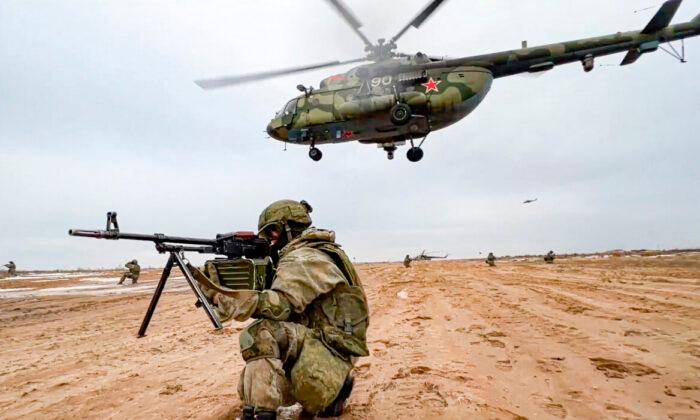The Russian invasion of Ukraine has sparked a flurry of social media postings, semi-informed news media articles, and much speculation.
The Fog of War has extra dimensions to it, but remember some simple home truths about the Russian Army. Notwithstanding our admiration for the courage and determination of the Ukrainians, the issue might not be hanging in the balance.
Putin’s key general in this war is Colonel General Alexander Alexandrovich Zhuravlyov, commander of the Western Theatre—which is to say, all of Russia’s military assets being used against Ukraine. With 40 years of experience, General Zhuravlyov is extremely professional. Except during Stalin’s reign of terror, Russian generals have tended to be very good at operational planning.
Remember, Russia’s generals took the Czar’s Armies from Moscow in 1812 to Paris in 1814, driving Napoleon to his exile in Elba. An 18-month drive that liberated Prussia and Austria—on Napoleonic-era logistics? This was quite the achievement!
In World War 2 on the Eastern Front, Hitler came to overrule his generals while Stalin, after months of disastrous defeats, eventually learned to listen to his. Once the balance swung in the fall of 1942, the Red Army hammered its way to Berlin.
Like the armed forces of just about all European and North American nations, the size of the Russian Army has shrunk enormously in the last 40 years. The Russian armies (which approximate Western corps) in the last decade of the Cold War were frighteningly armed—the formations that spent so long poised to spring into West Germany still exist, but have a quarter of the manpower they once did.
Russia’s armed forces are the smallest they have been since the 18th Century, and the 200,000 troops earmarked for the invasion of Ukraine are an enormous share of their 1,027,000 regular personnel—including the Strategic Rocket Forces, the Navy, Aerospace Forces, etc. Russia economized the most on their manpower in one area—the Army is very short of infantry units right now, and most are under-manned.
Since the Napoleonic Wars, cities have had the ability to soak up infantry like a sponge. A modern infantry platoon can cover a kilometer of frontage in open ground easily enough, but would be hard put to defend (or capture) a tenth of that in a city. High rises, concrete construction, open streets… a defender’s paradise, and an attacker’s nightmare.
The Russians have concentrated on tanks, artillery and helicopters to make fast, flexible formations for fluid maneuver in open ground… tanks and helicopters are easy meat in urban areas. That leaves artillery.
The Russian army has long loved artillery, and has ever since the days of Ivan the Terrible in the 16th Century. Russians are not good gunners, but mass has often made up for poor quality. In recent years, Russian artillery in Grozny and in Syria has turned whole cities into gravel-sized ruins. They can do this to the cities of Ukraine; and the process has already started.
Where the Russians are not so good are logistics… not that they are inept, but that there is a traditional discounting of the welfare of troops and a belief that combat troops are, well, expendable. Reports of stranded convoys out of fuel and hungry troops looting grocery stores should not be discounted.
Such accounts should not also be overweighted. Russian generals advance in echelons (waves, if you like, though it is not accurate). When a leading battalion has stopped, another one takes over the lead and drives on. Only then is the stalled battalion refueled, given rations, and a pause to absorb reinforcements. This may be hard on the troops, but this has always been thus.
What is more variable is Russian morale. When inspired, Russian soldiers have done great things; when not, not so much. Stalin learned the stick of coercion was not working so well in 1941 and early 1942, and successfully invoked the carrot of patriotism. However, in 1916, after the failure of the Brusilov offensive, Russian troops started to desert en masse—a scene vividly portrayed in the film Dr. Zhivago.
Most of the rank and file in the Russian Army have always been conscripts, and life as a conscript soldier is hard. Rations are bad, bullying (still) by older cohorts is endemic, and Russians are not like many Western troops, who expect to be told what is going on.
However, even in Putin’s Russia, much of the World’s modern spirit has percolated through. Are Russian conscripts prepared to believe Putin’s truths, or are they likely to be unwilling to make their despotic president and his chums even more wealthy? Russian conscripts dislike being lied to as much as the rest of us, and the interventions in Hungary in 1956 and in Czechoslovakia in 1968 did a lot of harm to the state of mind of Russian soldiers.
Finally, while the average Russian family in World War 2 had four children, and their society was—just—able to bear the war’s massive casualties. The world is different now. An average Russian conscript has no siblings and is the sole hope of his two parents and four grandparents…. If Ukrainian statistics about Russian casualties are true, Russia might be in for a startling demographic shock.
The Russian plan to invade Ukraine may work—it is well-designed and has sufficient resources (except for infantrymen). However, will Ukrainian resistance, despite the incredible damage being wrought by Russian firepower, be enough to undo Russian military morale? We will all know the answer to that soon enough.

